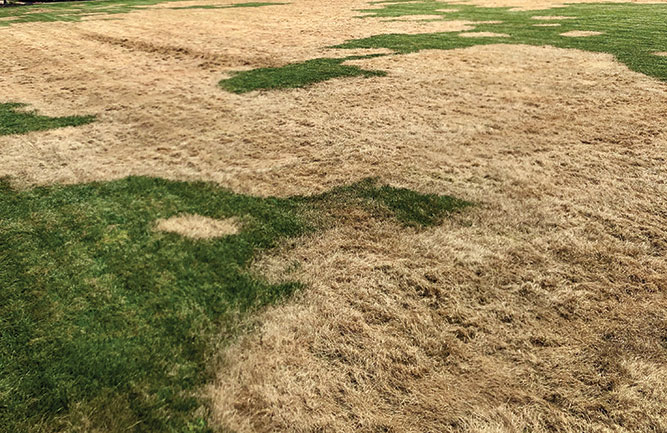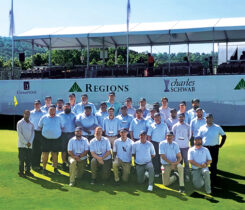Turf MD: What happened to my turf?

Fall armyworm damage near Mount Vernon, Ohio. (Photo: Karl Danneberger, Ph.D.)
As the summer comes to an end, recapping agronomically follows, in many ways, a similar pattern. Dollar spot, brown patch and summer patch were issues on numerous golf courses, as well as annual bluegrass weevil from the east coast through Pennsylvania. Surprisingly, anthracnose, which was severe in some areas, was not as severe as in past years. Crabgrass had a strong year, as well as annual bluegrass. Although all of these examples are serious agronomic issues, we often treat them like “another year.”
However, this year, the fall armyworm invaded and devastated turf through the Upper Midwest. Normally a sporadic or localized pest in the North, this August, it caused devastation across golf courses and home lawns. The insect’s name is quite appropriate. Fall is the time of year this pest causes damage, and army refers to how it marches across the turf or through a field like an army devouring the vegetation.
Fall armyworm is a chronic problem on turf in the Southeastern United States. The insect overwinters in southern Texas, southern Florida, Central America and South America. Anywhere north of these areas the fall armyworm can’t survive the winters, even in regions like central Alabama. In the spring, the moths migrate north by being carried on wind currents. The moths can travel 500 miles on wind currents in a 24-hour period. The moths become present in the Southern United States in late July and August. A moth can lay eggs, resulting in several hundred to a thousand or so caterpillars hatching.
The egg masses are often laid on light-colored surfaces. This could be on flags, hole markers, bridge railings, almost any flat surface. Once the eggs hatch, which can be days after laying, it takes about two weeks for the larvae to become fully grown. At this point, the caterpillars will burrow into the ground (pupate) and then emerge as adult moths in about two weeks. The caterpillars are most evident in the early morning or during late evening but have the potential to feed all day.
Damage, which looks like drought, comes quickly. A turf area, whether a golf course rough or a home lawn, can look fine one day, but in a few days, it can become defoliated. Defoliation can continue as the caterpillars continue to “march” along the turf. What made this year out of the ordinary throughout the Southeast and Northern United States was the early arrival of the fall armyworm with higher infestation numbers than expected, contributing to a rapid defoliation of the turf.
Some perspective on how quickly this pest can spread and cause devastation occurred four years ago. In January 2016, a shipment of maize infested with fall armyworm arrived in West Africa. One year later, fall armyworm assessments found the pest in 12 sub-Saharan African countries, devastating hundreds of thousands of acres at a cost estimated to be between $3 billion and $6 billion. In the United States, fall armyworm damage is mitigated by maize (corn) that is genetically modified to combat the pest. In Africa, there is widespread resistance to using genetically modified crops. In turf, several products are available to control fall armyworm.
Besides golf courses, the most popular topic in garden centers and neighborhoods was fall armyworm. I can’t remember a time when both professionals and nonprofessionals (homeowners) became so knowledgeable of a pest in a short period of time. Around Labor Day, I visited a few garden centers. Standing in line at the cash register line at a garden center the No. 1 topic of discussion was not Ohio State football but the fall armyworm and how it was killing their lawns.
The fall armyworm made this year more than your typical “run of the mill” year. I wonder if this pest is an indicator that pests may start occurring sooner, lasting longer and with an increased intensity than what we have seen in the past. The management of golf courses is difficult enough without having to plan for the unexpected.












